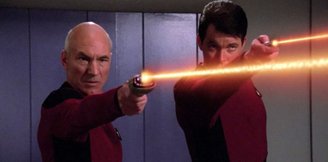It was created by Gene Roddenberry in 1966. Science fiction series Star Trek has become one of the greatest works of popular cultureAs well as Star Wars, Doctor Who and other productions that appeal to a futuristic universe.
More than 10 more movies and dozens more seasons have been produced since the original series debut; In fact, the cultural phenomenon was so big that the scientific concepts in the series influenced some real-life technologies.
Because it was developed in the mid-1960s, the technology offered by the franchise had not yet reached the level we know today. But the imagination of scriptwriters and scientific advisors made it possible to turn the ideas into reality. For example, Automatic doors in the classic series have been widely used all over the world since the 1970s.
If you’ve been following the franchise, you probably know that space-faring scientists have a replicator that makes it possible for various items to materialize. We haven’t reached that level yet, but current 3D printing technology allows for a somewhat ‘similar’ process – of course, without the materialization part. It is possible to print objects, food and even organs with 3D printer and different filament types.
“Star Trek and NASA have had a strong connection for many years; The former was inspired to write stories about the future by NASA’s current activities, while the latter was inspired to do great things now by the stories we’ve all seen. Both benefited greatly from this ongoing interaction. Hubble Space Telescope Operations Project Scientist Ken Carpenter, Star Trek Science Advisor Dr. “Macdonald was an obvious choice to join the crowd of people who have visited Goddard over the years and discovered this connection,” Erin Macdonald said during her visit to NASA.
Just like different science fiction works, Star Trek took cues from consultants to include scientific concepts that were real and other concepts that could theoretically be real. I have prepared a text containing information from scientists and experts so that you can better understand the representation of science in the films and TV series of the series.
Are the scientific concepts and technologies of Star Trek real?
Star Trek is not the first work of science fiction to use scientific concepts and technologies that reach the real world. For example, many books from the 1930s presented innovative ideas that became reality or were later studied by scientists and researchers.
“Dozens of today’s scientists, engineers and physicists, as well as mathematicians, chemists and even astronauts, were inspired by Star Trek as children to devote themselves professionally to these fields,” said the author of ‘Star Trek: the official guide’. Our universe’, as Andrew Fazeka comments on the franchise’s impact on the education of many working scientists.
antimatter
Antimatter is an actual scientific concept first mentioned in the original series from the 1960s, but has also been mentioned in many other works in the saga. Movie production appeals to engines using antimatter and Although this is not yet a fact, antimatter.
The scientific concept of antimatter was first proposed by physicist Paul Dirac in 1928, but began to become popular after the release of Star Trek. As the name suggests, antimatter is the opposite of matter; Science explains that for every particle there is an opposite particle with equal properties but opposite electrical charge. For example, for every electron there is a positron, and for every proton there is an antiproton.
tachyons
Like antimatter, tachyons were mentioned several times in Star Trek, but the scientific concept existed before the saga. It is a hypothetical particle that can exceed the speed of light in its natural state. The hypothesis was first proposed by German physicist Arnold Sommerfeld and later examined by many scientists.
In franchise, Tachyons are used to enable fast travel and equip many other fictional technologies. Although predicted to be the real thing in theory, the hypothetical idea has never been confirmed in experiments with real particles.
phaser
Phaser (PHASed Energy Rectification) is a weapon used in the series to injure or simply immobilize an enemy; More simply, it is a type of laser weapon. Although there is nothing similar to Phaser yet, science suggests that it is possible to produce weapons using laser technology. For example, the US Army Air Defense Division is developing a type of Phaser that can destroy unmanned aerial vehicles.

robots
Robots have been mentioned in science fiction works for hundreds of years, including Star Trek. In the TV series Star Trek: The Next Generation, the character Data is a robot with human appearance and mental characteristics. We’re not there yet, but many companies are already working to create functional androids, such as SpaceX.
With the development of artificial intelligence and technological materials, It is possible that the future will be full of functional robots that assist humanity in various tasks. Until that happens, we can keep watching Star Trek.
Did you like the content? So, stay updated with more curiosities about astronomy at TecMundo. If you wish, take the opportunity to learn which science fiction concepts are ‘possible’ in theory.
Source: Tec Mundo
I’m Blaine Morgan, an experienced journalist and writer with over 8 years of experience in the tech industry. My expertise lies in writing about technology news and trends, covering everything from cutting-edge gadgets to emerging software developments. I’ve written for several leading publications including Gadget Onus where I am an author.













